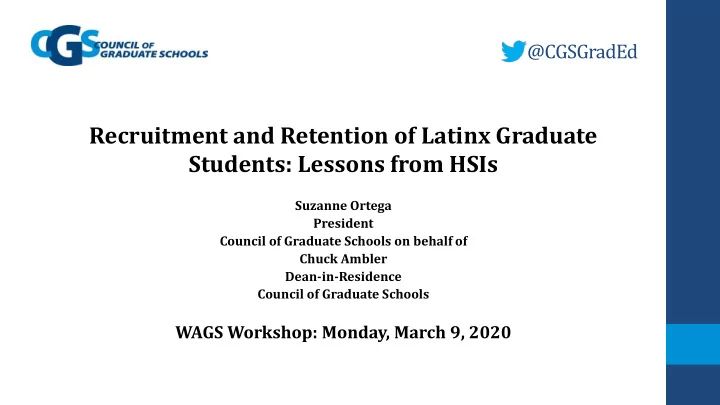

@CGSGradEd Recruitment and Retention of Latinx Graduate Students: Lessons from HSIs Suzanne Ortega President Council of Graduate Schools on behalf of Chuck Ambler Dean-in-Residence Council of Graduate Schools WAGS Workshop: Monday, March 9, 2020
Background Notwithstanding decades of programs designed to boost the enrollment of Latinx and other underrepresented groups in graduate programs, the proportion of Latinx students enrolled in graduate programs remains low. During this same period Latinx enrollment in undergraduate programs has expanded substantially. That growth has occurred disproportionately at Hispanic Serving Institutions. The role of HSIs in graduate education, however, has remained largely unexamined. @CGSGradEd
Perspective: • Research project undertaken at CGS by Dr. JoAnn Canales • The development of graduate education at UTEP where Chuck Ambler was Dean until 2019 Format: Overview: 20 minutes Breakout discussions: 25 minutes Summary discussion: 10 minutes Issues for break-out discussion: @CGSGradEd
Graduate Enrollment: Domestic Students 2017 White 1.6 million 63.3% Black 365,000 14.2% Hispanic 275,000 10.7% Asian/Pac. Islander 214,000 8.3% 2018: Hispanic population 25+ yrs: 4.1% have a master’s degree vs. 9.5% of whites. Although the grow of the Latinx population is slowing, Latinx make up the fastest growing segment of youth (college and graduate school age) population. Data show that Latinx rates of educational attainment at each level are low. @CGSGradEd
Hispanic-Serving Institutions: A critical Pipeline to graduate School for Latinx Students JoAnn Canales, PhD, Dean-in-Residence Council of Graduate Schools, 2018-2019 Project undertaken with the participation of David Ortiz PhD., Senior VP at HACU Research Program: Initial focus groups at CGS and HACU meetings Analysis of most recent data (2017) from NCES and IPEDS Surveys from HSIs that have graduate programs and follow-up phone interviews with a smaller group of institutions • More than 200 HSIs that offer graduate programs (out of a total of approximately 525) • 41% of Latinx graduate students are enrolled in graduate school at HSIs @CGSGradEd
Project Issues and Findings • HSI designation is based on undergraduate enrollment (25% Hispanic) • Many of the HSIs with large graduate enrollment are highly diverse institutions • HSIs that offer graduate programs include leading research universities and predominantly master’s institutions • Latinx populations are diverse and differentiated and that is reflected in the institutions @CGSGradEd
Project Observations: • Latinx remain highly underrepresented at the graduate level, especially the PhD but also master’s and professional degrees • The proportion of Latinx college graduates attending graduate school is significantly lower than for white students • The number of HSIs offering graduate programs has more than doubled in the last two decades • The HSI designation is not necessarily reflected in degree of attention paid to Latinx graduate students • Latinx faculty and administrators are often underrepresented at HSIs • HSIs do not necessarily focus recruitment and retention strategies on Latinx students @CGSGradEd
UTEP Case Graduate Enrollment • 25,000 total enrollment, approx. 15% graduate • Total enrollment: approx. 3,700 25% doctoral • International = 15% • Domestic graduate enrollment = 72% Latinx (PhD 40-50%) Total undergraduate enrollment 85% Mexican American @CGSGradEd
UTEP Programming • Broad university commitment to substantial Latinx enrollment and graduation in all doctoral programs, but • Little programing focused specifically on retention of Latinx graduate students • Little programing aimed at developing faculty awareness of issues and needs of Latinx graduate students @CGSGradEd
Top producers of Hispanic STEM master’s and doctoral degrees Excellencia in Education, 2015
Top Baccalaureate-origin Institutions of Hispanic U.S. Citizen and Permanent Resident Doctorate Recipients, and Percent with S&E Doctorates in the 50 States: 2014 Hispanic Doctorate Hispanic Doctorate Recipients, All Recipients, S&E Percent Doctoral Fields Doctoral Fields S&E Field University of Texas at El Paso 52 37 71.2 University of Texas at Austin 43 26 60.5 University of Florida 42 32 76.2 University of California, Los Angeles 36 24 66.7 University of California, Berkeley 34 23 67.6 Florida International University 32 26 81.3 University of New Mexico, Albuquerque 27 15 55.6 Texas A&M University, College Station 23 19 82.6 University of California, San Diego 23 18 78.3
Percentage of Doctoral Students With UTEP Undergraduate Degrees (Fall 2008 - Fall 2017) Fall Fall Fall Fall Fall Fall Fall Fall Fall Fall 2008 2009 2010 2011 2012 2013 2014 2015 2016 2017 Ph.D. 31% 36% 36% 36% 36% 37% 39% 38% 38% 36% Professional Doctorate 49% 58% 58% 49% 46% 50% 51% 49% 48% 50%
Breakout group discussion: • Why have the participation rates for Latinx graduate students continued to lag substantially? • What are the promising practices on your campus, or that you are aware of, re Latinx graduate student recruitment and retention? • What role will systemic initiatives, e.g. NSF INCUDES, on expanding Latinx participation? • Would or should HSI strategies for recruitment and retention of Latinx students differ substantially from those of other universities? This one is required: • If research was undertaken on Latinx students in graduate school, what questions do you think it is most important to address? @CGSGradEd
Recommend
More recommend